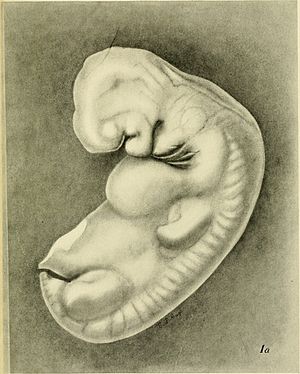Susanna Phelps Gage facts for kids
Quick facts for kids
Susanna Phelps Gage
|
|
|---|---|
| Born |
Susanna Phelps
December 26, 1857 Morrisville, New York
|
| Died | October 15, 1915 (aged 57) |
| Nationality | American |
| Alma mater | Cornell University |
| Occupation | Embryologist |
| Spouse(s) | Simon Henry Gage |
Susanna Phelps Gage (1857–1915) was an American scientist. She studied embryology and comparative anatomy. Embryology is the study of how living things develop before birth. Comparative anatomy looks at how different animals' bodies are built.
Susanna first studied the bodies of small animals and humans. Later, she focused on neurology, which is the study of the brain and nervous system. She wanted to understand how the brain develops. She also created a new way to make models for teaching anatomy. Instead of using wax, she used paper.
Even though Susanna Phelps Gage was a respected scientist, her work was sometimes overlooked. This often happened to women scientists in her time. Their research was sometimes seen as less important than their husbands' work.
Contents
Early Life and Education
Susanna Stuart Phelps was born on December 26, 1857. Her hometown was Morrisville, New York. Her father, Henry Samuel Phelps, was a businessman. Her mother, Mary Austin Phelps, used to be a schoolteacher.
After her parents passed away, Susanna gave their home to Morrisville in 1903. It became the Morrisville Public Library. Today, it is a historic building.
Susanna went to Cazenovia Seminary for her early education. In 1875, she started at Cornell University. She studied many subjects like Latin, English, history, and science. She was the first woman at Cornell to take a physics class in a lab.
While at college, she became very interested in zoology (the study of animals) and anatomy. She took every class offered in these subjects. She earned her Ph.D. from Cornell in 1880.
In 1881, Susanna married Simon Henry Gage. He was a professor at Cornell. They had a son named Henry Phelps Gage. He grew up to be a physicist and inventor.
Research in Anatomy and Embryology
After getting her Ph.D., Susanna Gage did her own research. She studied comparative anatomy and embryology. Many women scientists in the late 1800s did not have official jobs that matched their skills. Susanna often helped her husband with his work. She edited his book, The Microscope, and drew pictures for his papers.
Her work was sometimes overshadowed by her husband's. For example, an early science book listed her as "Mrs. S.H. Gage." But she became a well-known scientist in her field. She published her research in important journals like Science.
Susanna was chosen as a fellow of the American Academy for the Advancement of Science. She was also a member of several other important science groups. These included the American Anatomical Association.
Early in her career, Gage studied the muscles of small animals like turtles and birds. Her research helped scientists better understand how these muscles work. In 1904, she joined a research team in Bermuda.
Exploring the Brain: Neurology Research
Susanna Gage became interested in neurology when she was a student. She took classes with a Cornell zoologist named Burt Green Wilder. In 1905, she decided to study neurology more deeply. She went to Johns Hopkins Medical School and then Harvard University.
These studies changed her research focus. She began to compare the brains of different animals. She also studied how the brain develops from an embryo. Ten of her 26 solo papers were about neurology. These are considered her most important scientific works.
Making Anatomical Models from Paper
Susanna Gage was a talented artist. She drew pictures for her own science papers and for some of her husband's papers. She was also the first person to show how to make anatomical models from paper. Before her, most models were made from wax.
She thought paper models were easier and cleaner to make. They were also lighter and lasted longer than wax models. Other scientists copied her method. They even improved it. This method was used until the 1930s, when new ways of making models appeared.
Supporting a National University
Susanna Gage believed that America should have a national university. This idea came from George Washington. In the mid-1890s, she helped start the George Washington Memorial Association. Their goal was to make this national university happen.
In 1904, this association helped Columbian University in Washington, D.C., grow. The university then changed its name to George Washington University.
Susanna Gage was not well for the last four years of her life. She passed away suddenly on October 15, 1915, at age 57. Her husband lived for almost 30 more years.
Legacy and Impact
After Susanna Gage died, her husband and son created a memorial fund in her name. This fund helped build a room in a new women's dormitory at Cornell University.
In 1918, they created the Susanna Phelps Gage Fund for Research in Physics at Cornell. This honored her role in helping women in science at the university. Some of her papers and letters are kept in the Cornell University collection.
Yale University has some of her histological slides. These are very thin slices of mouse brain that she prepared in 1894.


